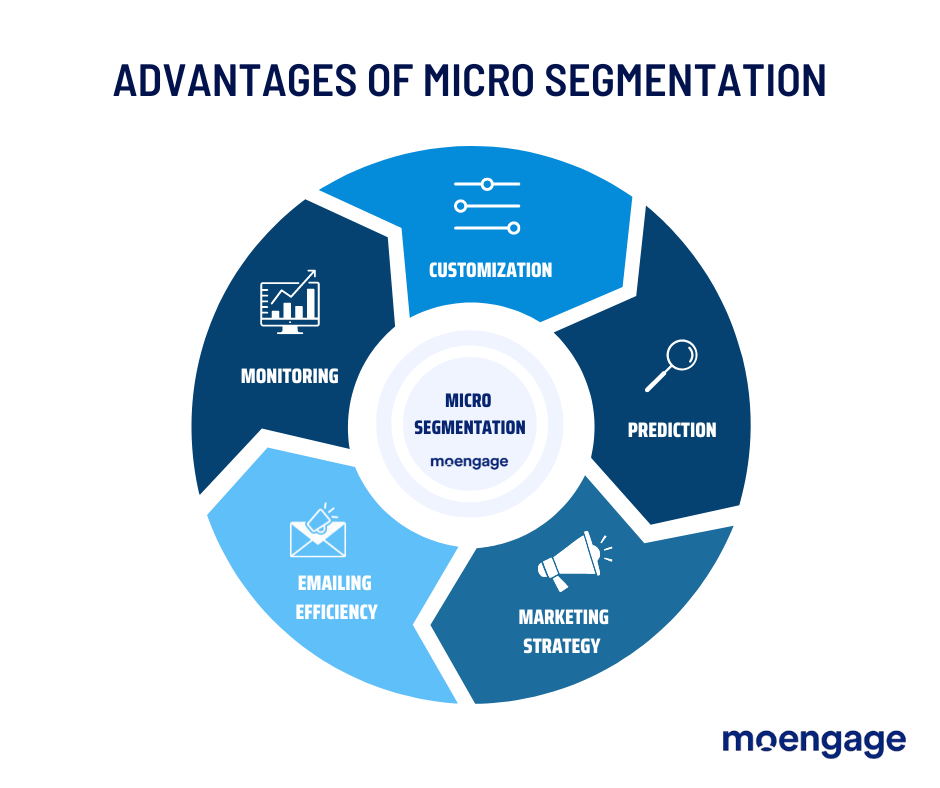Micro-Segmentation Marketing: What It Is and How To Do It

Reading Time: 7 minutes
Sometimes it’s just better to dive into the basics because what do you know? Others aren’t putting it to the test.
It has been almost six decades since Wendell Smith first introduced the concept of customer segmentation based marketing to the more complicated product differentiation process.
However, most of the market still fails to grasp the process, thus often failing to launch their products or services with an adequate boom.
However, segmentation marketing is already quite effective for the small percentage that does acquire experts on the matter.
Micro-segmentation marketing takes it to a granular level, skyrocketing sales, keeping the boss and customer content, and naturally attracting some of the more tech-savvy companies. So let’s break it down.
MoE Tip: If you’d like to get a quick demo on how MoEngage can help with your customer micro-segmentation, click the button below.
What is Micro-Segmentation Marketing?

Segment marketing suggests that companies divide up their customer base into sub-categories, targeting their products better and marketing with more efficacy, driving up profits.
The usual categories for this are Behavioral, Psychographic, and, most commonly, Demographic and Geographic.
However, this will help you scratch the surface. Micro-segmentation takes its levels further by dividing these groups into more minute levels. This is done by studying more concentrated behavioral patterns or predictions. After that, several different attributes from all these categories are combined and segmented.
For instance, gyms, athletic wear, or sporting gear companies market to young women between the ages of 20 to 30 looking up fitness equipment and strategies.
The process of micro-segmentation helps you understand your clientele in more depth and their needs a little better, having them attuned to you by offering them ‘exactly’ what they want. The kind of sportswear they prefer, the specifics all become very relevant in this case.
| Bonus Reads 👉 CDP vs. CEP: Do you know which one is more suited for your brand? The blog breaks down the myths related to customer data platforms and customer engagement platforms. |
What Are the Advantages of Using Micro-Segmentation?

If done right, a properly implemented micro-segmentation strategy can return you 10 to 15 times the investment amount.
Moreover, it promises faster growth, boosts profits, and lets you steer ahead of the cutthroat competition around you.
And in a technologically handicapped world, this is one of the safest and most financially fruitful crutches to rely on. Here’s a list of a few benefits that attest to that:
1. A Customized, High-Quality Digital Experience:
From booking doctor consultations to ordering a midday meal, we always turn to mobile devices.
And that convenience is only furthered when we can fine-tune our options to our preferences rather than scrolling through an array of options.
When you can appeal to and predict the customer’s exact demands and requirements, you’re more likely to welcome clients than website perusers. And micro-segmentation offers you a personalized A+ experience that keeps your clients coming back.
Moreover, It is as if technology can assess your needs better and quicker than you can, and who would likely turn away from that?
2. Monitor Changes in Movements Within Segments:
Our needs are changing as fast as the developments in the market.
While a gaming headset might be more appealing to you now, your priorities might shift to obtaining a home theater for your family.
From trying out a body lotion to a new diet, micro-segmentation can help by deploying monitors to analyze even the slightest shift in buyer patterns. This allows the marketing processes to adapt to the change in buyer needs.
3. A Certain Venture Rather Than a Game of Chance:
With most marketing strategies you come up with, all you are provided with are vague promises of better results. However, how micro-segmentation works can be implemented to predict a somewhat concrete range of your profits today or in the future.
Hence, this will also help you know where you might stand in the future financially and opt to make changes if needed.
4. A Gem Amidst Marketing Strategies:
The success of any company today heavily depends on marketing.
Whether your products appeal locally or globally to teens or adults, single or married individuals, micro-segmentation helps you steer through such massive bundles of data effortlessly.
This intelligent software, which would seem almost magical to one unaware of the process, simply relies on collecting data through surveys, monitoring website movements, sign-in information, and so on.
Not only is it a great strategy to work independently, but it also helps improve your other strategies further.
5. Increase Efficiency in Email Marketing:
Tired of sending out a few thousand emails daily and returning with some to almost no response? Email marketing is one of the oldest marketing processes to have withstood the test of time, but the way it works remained unchanged. For example, Micro-segmentation helps E-commerce businesses send emails efficiently to potential clients rather than sending you on a blind spree, returning more than usual click rates. After all, you wouldn’t open an email unless it’s exciting or familiar enough.
| Bonus Read 👉 Email Marketing Benchmarks by Industry | 2022 [Download Case Study] |
How to Establish Micro-Segmentation Marketing?
Several studies have proved that people often prefer targeted ads to random ones.
It entails that your clients are all about transforming the customer experience into a more personalized and high-quality. But before you go about crafting one, let’s establish the basics that you need to know.

How to Easily Differentiate between Micro and Macro Segmentation?
Micro and Macro – one that relies on minute data and subcategories and the other that depends on much broader aspects.
Micro-segmentation will work on a buyer’s browsing history, purchase history, purchase criteria, and so on. Whereas Macro-Segmentation will work on your buyer’s location, language, clothing size, and so on. The size differs in the fields.
What you’re returned with will also in fact differ in size or quantity, While Micro-segmentation will offer you fewer but larger and more heterogenous fields of buyers. Micro-segmentation will provide you with more groups with a lesser number of individuals who are more united by their needs, thus turning your probabilities into solid numbers.
More than often, a micro-segmentation strategy evolves into a micro-segment marketing process. With time, more data comes to hand, helping companies be more efficient with the latter.
| Note: Personalization is a proven way to capture user interest and loyalty. Read here to learn how website personalization can be used. |
The Types of Customer Micro-Segmentations

While you are entirely free to choose and build your segments. For now, let’s work with the more commonly tested ones- Behavioral, Geographic, Demographic, and Psychographic- and further identify their possible micro-segments.
Behavioral – One of the most effective categories, this works on more minute information such as window shoppers and their items, or items repeated in the purchase, purchase intent, etc.
Geographic – Here, the categories are, as suggested, location-wise, for instance, sectioning nations, states, cities, and metropolitans. And further categories like whether it’s a cold or tropical place, urban, rural or semi-urban, and more.
Demographic – Demographic subsections can be made with age, gender, religion, education, income, and more, tending to the more socio-personal needs.
Psychographic – Here, the sub-categories are more personality traits or value-oriented. For instance, categorizing fantasy book readers or fanatics, avid travelers, technologically upgraded and savvy individuals, individuals into vintage or Avant-Garde fashion, and so on.
How to Craft Your Micro-Segmentation Strategy?
Now that you know how to work your macro-segmentation strategy into a micro-segmentation one and its categories, let’s go through the proper steps.
Step 1: You cannot develop micro-segments without creating your broader segments first. For the work will only seem tougher. Establish your broader categories first. Let’s work with the ones we’ve already established.
Step 2: Once you know your main fields, you can further identify your mini sections where the customer needs are more united and focally addressed. This is not something one can do manually.
Well, thankfully, plenty of algorithms, data mining strategies, and AI tools can help you with it. These can help by studying client behavior throughout the website. They’re perusing their purchase history, pushing their abandoned carts or wishlist items, etc., and going under behavioral.
You can further work your micro-segments as suggested under Demographic, Psychographic, and Geographic. These can range from identifying fitness enthusiasts of a specific age range to art enthusiasts of a locale.
Step 3: It’s all about quality, not quantity, and that’s what Micro-segmentation marketing crutches on.
You’ll have a more fine-tuned selection of potential customers for a product, and you can offer them a similar yet more personalized and elevated experience. Don’t worry about your micro-segments overlapping. Your varying audiences can still share their exact needs.
For instance, your traveling comfort gear and equipment may appeal to young adults and even advertise to grandparents accordingly while also advertising to avid hikers, rock climbers, surfers, and other adventurers.
We asked Zach Grove, growth marketer and former employee #4 at Drip, how to get started with interest-based segmentation.
From Zach: “One quick win is to build segments of customers who’ve made 3+ purchases in a specific product category. For a clothing brand, for example, you might build a segment called Frequent Buyers: Men’s Shirts. From there, you can test sending more frequent emails featuring SKUs in the Men’s Shirts category—knowing that these folks are likely to be interested.”
Now, let’s take another scenario into consideration. You are a graphic t-shirt seller. You can start with an age range, then the process would further establish a more minor group by selecting, let’s say, Game of Thrones fans or have at some point looked up similar merchandise. Now the next subcategorization would require you to choose a few who have looked up similar products in the last four to five months, and there you have one of your micro-segments.
MoE Tip: If you’d like to get a quick demo on how MoEngage can help with your customer micro-segmentation, click the button below.
Summarizing it…
Micro-Segmentation is the new generation’s solution to more effective, focused, and relevant marketing. Remember that no one’s needs are uni-dimensional. One might be attracted to scented candles as much as they are attracted to fashionable or athletic wear.
While one customer might always belong to more than one micro-segment, the mosaic of scores and hundreds of micro-segments might seem overwhelming. It will always be more effective than vague advertising with a few highly heterogeneous categories. And after all, you don’t have to do it all alone. There are plenty of tools and algorithms at your disposal and professionals ready to help you.
Bonus read table
Bonus Reads
|







